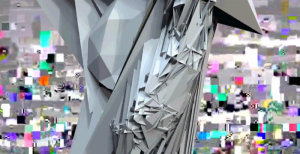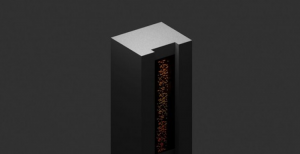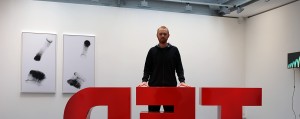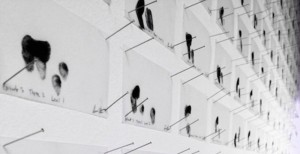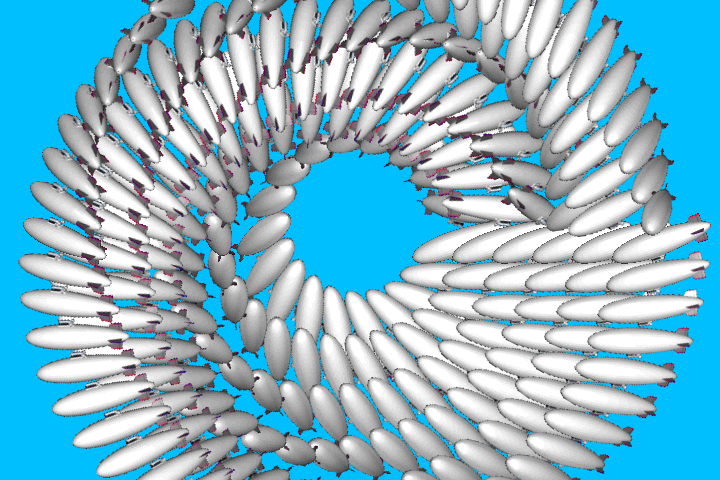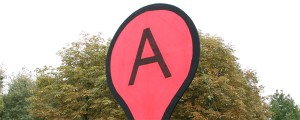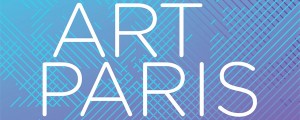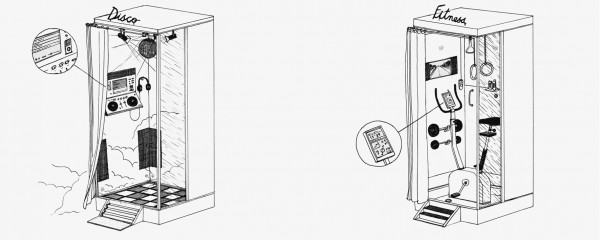At 35-years-old, Evan Roth is an emblem of transdisciplinarity across art and activism. He approaches contemporary art and the urban environment in the same way a hacker would approach software and programming –with a creative and manipulative insolence. Key words are “misuse” and “empowerment”, his philosophy is open-source and, between being a simple user and ‘true admin’, Roth knows his place on the Internet: the deep and empowering one.
Although he feels nowhere more at home than online, Roth is no digital native, which might be what distinguishes him as an artist. Adding depth and complexity to his art, the man is young enough to be an internet-junkie but old enough to look at the fascinating web with saving suspicion.
Eminent among Net art lovers, the public Roth persona has hitherto come accompanied by his friends and colleagues from his graffiti days. Thus we already owe him the Graffiti Research Lab, an artist and technologist collective cofounded with James Powderly and responsible for #pirateTED, and the Free Art and Technology Lab (F.A.T. Lab), another collective of activists who excel in playing with intellectual property laws (they’re the guys behind the parody of the rumored Google self-driving car).
From far away, it might look like a playground of big kids having fun with grown up rules, but Roth is a serious man, and now a father, who employs a clever strategy. Not only does he provoke media attention by attracting a mainstream audience with fun videos, performances and installations, but he also uses that to raise awareness, questioning preconceptions about the role of technology in daily life.
Going solo for the first time, Roth reaches further by exhibiting his work in the young and exciting XPO Gallery in Paris where he has been living for the last three years. But no need to worry because, suit or no suit, once a hacker always a hacker and View In Room is still full of humour, just the brilliant and very dark kind.
View in Room is your first solo show. How challenging was it for you to move from the Internet to the gallery?
Evan Roth: It’s a mixed feeling. Of course the audience on the Internet isn’t the same as the public of the gallery. But because a lot of my work is so engaged with the web, I kind of feel at home everywhere. This is also the first time I’ve done a show in a city where I live in, so this is my home too.
Why baptise the show with the piece ‘View in Room’?
ER: Whether you’re familiar with the Etsy website or not [an art-for-sale website], there’s something very awkward with the shape of this image that allows the user to view a piece of art on a virtual wall. It doesn’t feel real, because it’s not.
Beyond that piece, a lot of the work that I make is trying to talk about that really awkward connection that is happening between the Internet and the arts. I belong to the first generation that grew up with the Internet and from my standpoint, it seems more awkward to take a photo and put it on a fake wall than to do things with pixels. Because I think the Internet can be much more than a place to hang a jpeg on a fake wall. That idea of awkwardness goes through a lot of the pieces, not only this first one, but the first piece is indeed a sort of baptism.
Where exactly do you stand as an artist ?
ER: My specific generation is one who knew both sides. I knew the world before the Internet, I remember it and I don’t take the Internet for granted. When I got my first Internet account I just couldn’t believe I had so much power. I could say something, nobody could say ‘no’ or remove it and I could virtually reach an unlimited amount of viewers… I never had that feeling of empowerment again, so what I’m trying to do in my work now is to recapture that feeling and give it back, pieces by pieces, to other people. Because I think you miss it now.
This sounds very nostalgic…
ER: I guess so, but I do think that you make art about where you come from and this moment was a big one in my life. I’m happy that I grew up at that point, when I was old enough to understand what Internet could be, but critical enough to see what it could turn into. I have a daughter now, she’s only a few months old and she’s already seen pixels. She’s going to be introduced to a very different version of the Internet.
Does it also mean that you belong to the last generation that can have a critical view on the Internet?
ER: There are still very young artist making very critical, engaging work. So it’s not impossible to make this critical work without that standpoint artists from my generation do have. But I think it’s easy to take things for granted when you don’t know a world were the only way to be introduced to art, to music, to movies, is to hear from the older kids at the bus stop after school.
Could you give us an example of a piece sharing this empowerment feeling with the audience?
ER: When you enter the gallery, you can see the back of the TED sign. The piece is called ‘Identity Capital’ and, actually, the back is the front of the sculpture. But this sign has been conceived to always face the Internet and the audience.
There must have been only a few hundred people invited to be on stage and to see the backside of that sign. I also did a version of the TED sign as an installation in New York a few months ago. The idea was that you could come and stand in front of it and give your own talk. Also you’re sharing the same floor as the sculpture. By removing the stage that is usually reserved to the elite, we get to feel that power.
So your work is basically saying that if the Internet is a source of freedom and power, that freedom and that power are not where we think they are…
ER: It’s a good take. I talk a lot about empowerment and its relationship to misuse. Misuse comes a lot from hacking circles. It’s a way of approaching, not just technology, but culture. There are small changes you can make in the world around you, in a questionable way, sometimes even in an illegal way. But it’s not difficult.
The TED piece is a total misuse since it wasn’t meant to be used this way. It’s meant to be in the back of people who come to give un-curated speeches. The logo, bold and red, is extremely easy to be reproduced, but culturally we think that we can’t touch this thing, that’s it’s covered by a trademark. But we can do it. Misuse can have an empowering effect if it’s done properly.
The way you talk about hackers, or even graffers, it seems that you really belong to a community…
ER: Absolutely. Also with some of the artists that Philippe Riss is representing, Aram Bartholl, Constant Dullaart, we are people who feel more at home on the Internet than anywhere else. The art world is having this very slow time coming around to the fact that there’s now a new contemporary. It’s so hard for me to understand why our work would be hard for people who are professionally in the art business. But I’m quite optimistic.
The Internet is ephemeral by nature. How do you think about your work in such a context?
ER: I’m aware of the fact that the Internet is changing constantly and that this thing that I love is a moving target. Who knows how it will look like in a hundred years? A piece like ‘Zoom In, Zoom Out’ has a life right now because we do this movement with our fingers on our smartphones 20 times a day now but how will it look like in 50 years?
People will look back and wonder, ‘what were artists doing when they first touched pixels or when they first started writing codes?’ Of course, I feel comfortable with Twitter or Tumblr, and of course I’m participating in that culture, but what’s been more interesting for me in the last couple of years, is to think about how those things will age and how people will experience that in the next two or three generations.
Teaching younger students would be a good way to observe their own experience of the Internet…
ER: Definitely. I used to teach a lot to students who are “digital native” and one thing I notice is that their relationship with the Internet is as users and not as admins. They would get a user account on Facebook, on Youtube, on Flickr… All of their data would be stored on servers owned by Google or Yahoo.
When I was introduced to the Internet those services didn’t exist and I had to own my own server, to learn how to write html code or to upload a file on an ftp. It sounds like a small technical thing but it’s fundamental to know whether you’re an admin or whether you’re a user. How many students know what it feels like to be an admin, to run a server, the email accounts? That’s empowering. Look at Edward Snowden! Running a YouTube channel doesn’t give you the same feeling.
Could you present us with a piece of the show? Any one you want.
ER: Then I would choose the bigger one, ‘Level Cleared’. It’s just over 15-hundred sheets of tracing paper, the same size of an iPhone. On each sheet you can see fingerprints because I would put the sheet over my iPhone, pull up the game Angry Birds and play through the paper. I would ink my finger every time I would play. It starts with Level One, up the top left corner, and ends with Level 300 and you can kind of follow the game, with me losing or beating it.
A lot of my work deals with humour and pop culture references, but it’s also a dark view of what people call “casual computing”. We have powerful computers in our pockets but what do we use them for? I would love to see someone walk into the gallery, look at this piece and cry. **
Evan Roth’s View in room is on at XPO Gallery Paris and runs from October 10 until November 16, 2013.
Header image: Evan Roth. Photo by Pamela Pianezza
share news item
